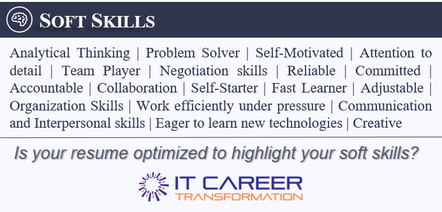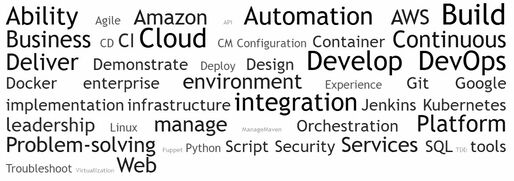IT Role-in-Review - Product ManagerLearn about the top skills and competencies companies look for when searching for a Product Manager.
Are you a seasoned IT Product Manager struggling with streamlining and optimizing your career documents (Resume, Cover Letter, LinkedIn Profile)? Working on transitioning into IT or already in IT but working on transitioning into a different role? Interested in Product management as a career path but not sure how to effectively communicate transferable experience and skills in a way that fits entry-level product management roles?
This month’s Role-In-Review article focuses on the Product Manager role. Regardless of your experience level, continue reading to learn what companies look for when searching for a Product Manager, including:
Use these insights and examples provided to optimize your career documents.
0 Comments
IT Role-in-Review - Network EngineerLearn about the top skills and competencies companies look for when searching for a Network Engineer.Are you a seasoned Network Engineer struggling with streamlining and optimizing your career documents (Resume, Cover Letter, LinkedIn Profile)? Interested in network engineering as a career path but not sure how to effectively communicate transferable experience and skills in a way that fits network engineering roles? This month’s Role-In-Review article focuses on the critically essential Network Engineer role. Regardless of your experience level, continue reading to learn about the top competencies, capabilities, and skills companies look for when searching for a Network Engineer. Use these insights and examples provided to optimize your career documents. IT Interview Prep TipsInterview Prep tips for IT Professionals – How to confidently answer common interview questions.
You are not alone. This article provides tips on how to put your best foot forward when interviewing for your IT professional dream job. Every company has different interviewing processes as part of their recruitment, and the process can vary by the specific role and particular types of interviews (i.e., behavioral, target role deep-dive, final management interview etc.). No matter what IT role you are interviewing for, most interviewers begin with generic questions and often follow up with more specific “why” type questions to ensure they learn as much as possible about you as a potential employee.
Read on to learn how to confidently answer these questions so you make an excellent first impression and stand out in today’s competitive IT job market.
IT Resume Writing TipsIT Career Transformation tips on how to keep your IT resume up-to-date.
If you are in the information technology (IT) industry, you already know the importance of keeping up with the rapidly changing demand, technology advancements, new methods, and tools that you might need to use in your next challenging IT role or project. Moving from one project to another using completely different technologies and methods within less than a year is very common in IT. Keeping track of new learning and accomplishments is essential and should be reflected on your resume.
Continue reading to learn about useful tips on how to keep your IT resume up-to-date. IT Role-in-Review - Security AnalystLearn about the top skills and competencies companies look for when searching for a Security Analyst.
In today’s world, cybersecurity is a priority for most companies. As the digital transformation across industries grows, more companies are exploring ways to ensure the protection of their proprietary information and systems. A Security Analyst resume (also known as cybersecurity analyst or information security analyst) has a vast array of responsibilities, including analyzing data to determine security risks, creating policies and procedures, and training other personnel on security issues.
Are you a Security Analyst who is looking to transition to an IT professional career or someone fresh out of college searching for the perfect IT career path that fits your skills? Having difficulty streamlining and optimizing your career documents (Resume, Cover Letter, LinkedIn Profile) with the essential keywords, your relevant accomplishments and experience? Interested in following an IT career path in cybersecurity but not sure how to effectively communicate transferable experience and skills in a way that fits this role? This month’s Role-In-Review article provides useful information for the Security Analyst’s IT professional career. Continue reading to learn about the top competencies, capabilities, and skills companies look for when searching for this essential IT role. Use these insights and examples provided to begin optimizing your career documents. IT Role-in-Review - Data AnalystLearn about the top skills and competencies companies look for when searching for a Data Analyst.
Are you an analytical person with a passion for working with numbers and considering an IT professional career? Are you a seasoned data analytics professional who excels in automating data flows and developing business intelligence solutions? If so, a data analyst role may fit perfectly into your career goals. Data and analytics are at the core of making intelligent business decisions. Data analysts are an essential part of any high-performing team because they take static data and transform it into understandable recommendations and communicate what the data means in a way that other non-IT stakeholders can clearly understand.
Interested in data analysis as an IT career path but not sure how to effectively communicate transferable experience and skills in a way that fits entry-level data analyst roles? Having difficulty selecting the appropriate keywords for updating your career documents (resume, cover letter, LinkedIn profile)?
This month’s Role-In-Review article focuses on the data analyst role. Regardless of your experience level, continue reading to learn about the top competencies, capabilities, and skills companies look for when searching for a Data Analyst. Use these insights and examples provided to optimize your career documents.
IT Role-in-Review - Project ManagerLearn about the top skills and competencies companies look for when searching for an IT Project Manager.
Are you a seasoned IT project manager struggling with streamlining and optimizing your career documents (Resume, Cover Letter, LinkedIn Profile)? Having a hard time fitting in all your years of experience, project accomplishments and selecting the right keywords?
Interested in project management as a career path but not sure how to effectively communicate transferable experience and skills in a way that fits entry-level project management roles? This month’s Role-In-Review article focuses on the project manager role. Regardless of your experience level, continue reading to learn about the top competencies, capabilities, and skills companies look for when searching for a Project Manager. Use these insights and examples provided to optimize your career documents. IT Role-in-Review - Business AnalystLearn about the top skills and competencies companies look for when searching for a Business Analyst.
Welcome to our Role-In-Review series. If you are in the Information Technology (IT) industry, you are probably aware of the high number of existing IT roles and how quickly new IT roles are entering the job market to keep up with the ever-changing IT industry demand for talent. Specializing in IT, IT Career Transformation has helped improve career documents (resumes, cover letters, LinkedIn/Social Media profiles) for IT professionals and leaders from over sixty different IT roles with different areas of specialties. We continuously analyze relevant job descriptions to identify critical and highly ranked keywords and skills, allowing us to excel at crafting outstanding career documents using relevant keywords for each IT role and specialty areas.
Our goal in this Role-In-Review series is to provide you with an insight to a specific IT role and useful content recommendations driven by IT industry demand that you can use to optimize your career documents and help keep them up-to-date. The first article in this series focuses on the Business Analyst role. Continue reading to find out what are the top competencies, capabilities and skills companies look for when searching for a Business Analyst.
Transition to IT - Resume Writing TipsTransitioning into IT? 10 tips to help you transform your resume to IT.Considering a career transition to the IT industry but you have little to no IT experience? Your existing resume has nothing to do with IT and you feel stuck? Whether you are working on transitioning into an entry-level IT role (i.e. Technical Support, System Analyst) or working on transitioning into a different role in IT (i.e., Quality Analyst to a Business Analyst) you probably already possess relevant experience and skills that you can leverage to position you in a positive light to your new target IT role. IT Career Transformation has helped many customers with their transition to IT. In this post, we share 10 tips and leading questions that can help you transform your resume and LinkedIn profile to your new target IT role. IT Job Search TipsHow to improve your IT job search.
The job search process can be a long, arduous journey. Applicants often receive an immediate rejection email or never hear anything about their application. Although optimizing your career documents to the target position is an essential step in your job search strategy, there are other factors that can affect your probability to be called for an interview. First and foremost, be patient and diligent. The old saying “patience is a virtue” has never been truer than when trying to land your ideal role.
Depending on the specific hiring company and the position you are applying for, each open position can have more than 250 applicants; of those, only 5-6 are interviewed and only 1 is hired. Many online sources such as recruiting agencies and tech communities suggest that most people spend an average of 2-4 months on their search effort, averaging 15-20 applications/week. Don’t let a few rejections discourage you from persevering! Below are 5 helpful tips for improving your job search efforts. The Optimum IT Professional ResumeIT Career Transformation tips on how to streamline and optimize your resume to your target IT role.
Experienced IT professionals generally have a vast array of role-specific experiences and skills. Sometimes it is difficult deciding which details to include on your resume. In fact, many clients come to us with resumes that are six or more pages and often ask: “how long should my resume be?” The short answer is: usually two pages for IT professionals.
I bet you are asking: How do I fit all my career details into two pages? This article provides great tips for optimizing your resume to the ideal length to pass through Applicant Tracking Systems (ATSs) into the hands of potential employers. IT Resume WritingHow to choose a resume writing service for IT professionals.
IT Professional Resume Writing TipsHow to improve your IT professional resume and get noticed by employers and recruiters.
Your resume and LinkedIn profile might be too crowded with technical language and lacking mention of your accomplishments that create value to employers and customers. In this post, we share recommendations on how to effectively demonstrate your value as an IT professional. We provide practical examples that can help you improve your professional experience/accomplishments statements and increase your visibility by employers and recruiters.
IT Resume Writing Tips - Soft SkillsIs Your IT Professional Resume Optimized to Highlight Your Soft Skills?
Your target IT role is in high demand. You possess the right technical skills and experience, but you still are not hearing back from recruiters and hiring managers?
More than ever before, companies are looking for the right soft skills when hiring IT professionals. Your resume and LinkedIn profile should be optimized to highlight your soft skills and clearly communicate how you fit in to the hiring company’s culture and work environment. In this post we share the top soft skills companies are looking for when hiring IT professionals. First, it helps you stand out from other candidates who do not bother to send a thank you email. Secondly, it is your opportunity to show appreciation for the time spent during the interview, and for the opportunity to learn more about the company, the position and being considered for it. Lastly, it is always important to follow-up. It provides an easy way for the interviewer to simply hit reply and let you know about the position, either way. Hopefully, they will let you know you are moving forward in the recruiting process and providing you with next steps. When should you send a thank you email? After the interview (phone interview, in-person or via video conference), ideally by end of day. Hiring decisions can be made fast, you want to show that you are interested in the position as early as possible. What to include?
Need help crafting a thank-you email? Here is a thank you email template that you can download and customize for your use:
A week went by and still no reply? Do not give up, send a short follow-up email. Hiring managers can be busy. Example for a follow up email: “Dear <Name>, In case you are still considering candidates, I am following-up to let you know of my sincere interest in this exciting position. I hope to hear from you soon with next steps. Best Regards, <Your Name> <Your Phone #>” Do you or someone you know need help advancing your IT career? Visit us at https://www.itcareertransformation.com/ for more information and to schedule your complimentary initial consultation. IT Resume Writing Tips - Resume IntroductionHow to create an effective IT resume and LinkedIn profile introduction
Can your resume tell your story in less than 10 seconds? Recruiters glance through many resumes until they find the one that draws their attention. Your resume and LinkedIn profile introduction should standout and be crafted effectively to catch their eye quickly and convince them you are the optimal candidate. In this blog post, we share tips on how to create an effective IT professional profile introduction (Resume and LinkedIn).
Optimizing your resume and LinkedIn profile with the right keywords is critical for ranking high in Applicant Tracking System (ATS) search results, and for evaluation done by recruiters and hiring managers to identify top candidates for the job.
Career Tips For IT Professionals - IT Project ManagerWhat are the three top skills for a successful IT Project Manager?
There is more than one good answer to this question. You should prepare your answer as this can be one of the questions that will come up in your next interview. And yes, it depends on the type of position you are applying for. A few considerations when preparing your answer: Is the position client facing? Is it part of a PMO or Delivery organization? What is the team size, structure and location? (e.g. global matrix structured team vs. co-located). Continue reading to learn about the top common skills companies look for when searching for an IT Project Manager.
|
|||||||
IT Career Transformation - Connecting Talent with IT Industry Demand
IT Career Transformation
Atlanta, GA
(470) 210-7955 - [email protected]
Copyright © 2022 All Rights Reserved













